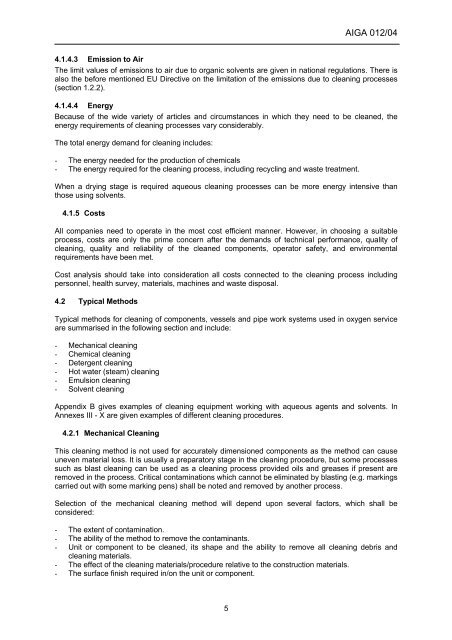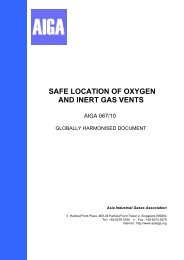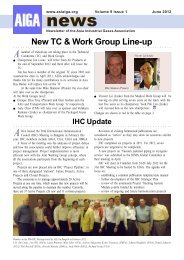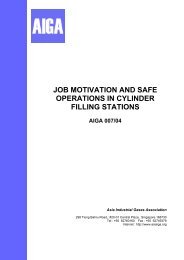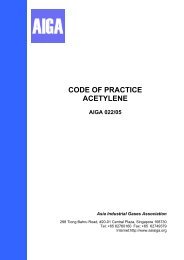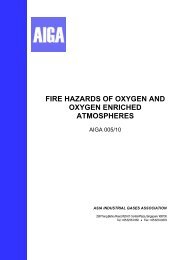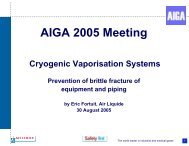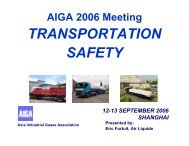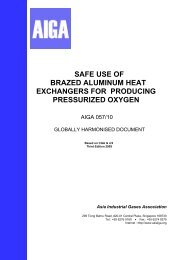CLEANING OF EQUIPMENT FOR OXYGEN SERVICE - AIGA
CLEANING OF EQUIPMENT FOR OXYGEN SERVICE - AIGA
CLEANING OF EQUIPMENT FOR OXYGEN SERVICE - AIGA
You also want an ePaper? Increase the reach of your titles
YUMPU automatically turns print PDFs into web optimized ePapers that Google loves.
5<br />
<strong>AIGA</strong> 012/04<br />
4.1.4.3 Emission to Air<br />
The limit values of emissions to air due to organic solvents are given in national regulations. There is<br />
also the before mentioned EU Directive on the limitation of the emissions due to cleaning processes<br />
(section 1.2.2).<br />
4.1.4.4 Energy<br />
Because of the wide variety of articles and circumstances in which they need to be cleaned, the<br />
energy requirements of cleaning processes vary considerably.<br />
The total energy demand for cleaning includes:<br />
- The energy needed for the production of chemicals<br />
- The energy required for the cleaning process, including recycling and waste treatment.<br />
When a drying stage is required aqueous cleaning processes can be more energy intensive than<br />
those using solvents.<br />
4.1.5 Costs<br />
All companies need to operate in the most cost efficient manner. However, in choosing a suitable<br />
process, costs are only the prime concern after the demands of technical performance, quality of<br />
cleaning, quality and reliability of the cleaned components, operator safety, and environmental<br />
requirements have been met.<br />
Cost analysis should take into consideration all costs connected to the cleaning process including<br />
personnel, health survey, materials, machines and waste disposal.<br />
4.2 Typical Methods<br />
Typical methods for cleaning of components, vessels and pipe work systems used in oxygen service<br />
are summarised in the following section and include:<br />
- Mechanical cleaning<br />
- Chemical cleaning<br />
- Detergent cleaning<br />
- Hot water (steam) cleaning<br />
- Emulsion cleaning<br />
- Solvent cleaning<br />
Appendix B gives examples of cleaning equipment working with aqueous agents and solvents. In<br />
Annexes III - X are given examples of different cleaning procedures.<br />
4.2.1 Mechanical Cleaning<br />
This cleaning method is not used for accurately dimensioned components as the method can cause<br />
uneven material loss. It is usually a preparatory stage in the cleaning procedure, but some processes<br />
such as blast cleaning can be used as a cleaning process provided oils and greases if present are<br />
removed in the process. Critical contaminations which cannot be eliminated by blasting (e.g. markings<br />
carried out with some marking pens) shall be noted and removed by another process.<br />
Selection of the mechanical cleaning method will depend upon several factors, which shall be<br />
considered:<br />
- The extent of contamination.<br />
- The ability of the method to remove the contaminants.<br />
- Unit or component to be cleaned, its shape and the ability to remove all cleaning debris and<br />
cleaning materials.<br />
- The effect of the cleaning materials/procedure relative to the construction materials.<br />
- The surface finish required in/on the unit or component.


